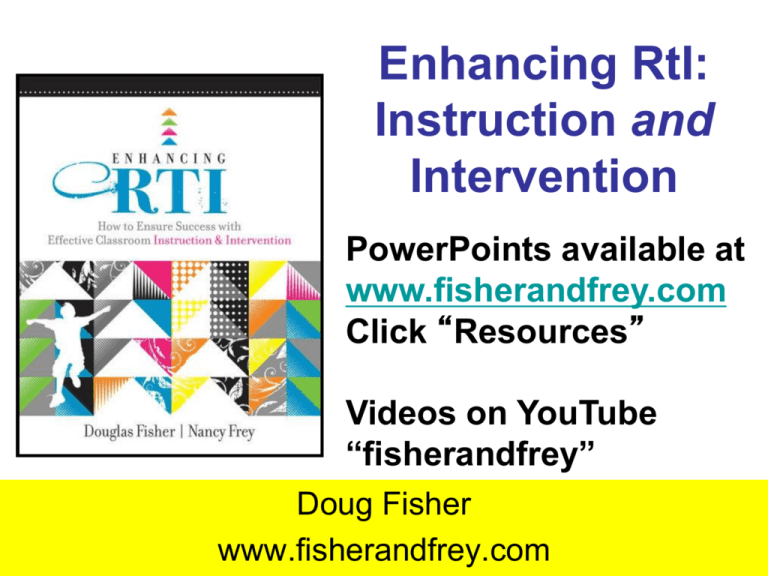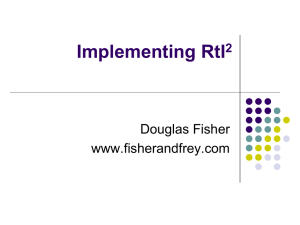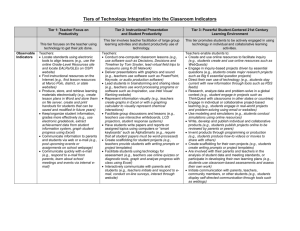Doug Fisher: April 19, 2012 PowerPoint Presentation
advertisement

Enhancing RtI: Instruction and Intervention PowerPoints available at www.fisherandfrey.com Click “Resources” Videos on YouTube “fisherandfrey” Doug Fisher www.fisherandfrey.com I’ll go back to school and learn more about the brain! 400+ page textbook “Somites are blocks of dorsal mesodermal cells adjacent to the notochord during vertebrate organogenesis.” “Improved vascular definition in radiographs of the arterial phase or of the venous phase can be procured by a process of subtraction whereby positive and negative images of the overlying skull are superimposed on one another.” “I don’t know how you’re going to learn this, but it’s on the test.” Quick, build background! Expand understanding through reading Reading increasingly difficult texts Read “non-traditional” texts • To date, over 100 YouTube videos! • PBS (The Secret Life of the Brain) • Internet quiz sites about neuroanatomy • Talking with peers and others interested in the brain But, the midterm comes 17 pages, single spaced, 200 multiple choice questions Besides some Neuroanatomy, what did I learn? • You can’t learn from books you can’t read (but you can learn) • Reading widely builds background and vocabulary • Interacting with others keeps me motivated, clarifies information and extends understanding • I have choices The teacher needed to… • • • • Establish learning goals Check for understanding Provide feedback Align future instruction with student performance Purpose of RtI An alternative way to identify students as having learning disabilities, making sure that students who struggle were not misidentified as disabled when different and/or more intensive instruction addressed their needs. Purpose of RtI An alternative way to identify students as having learning disabilities, making sure that students who struggle were not misidentified as disabled when different and/or more intensive instruction addressed their needs. A school improvement process designed to ensure that students receive the instruction, intervention, and support necessary to be successful. A school improvement process designed to ensure that students receive the instruction, intervention, and support necessary to be successful. Response to Instruction and Intervention (RtI2) Tier 1: 75+% Tier 2: 10-15% Tier 3: 5-10% Manipulate variables… Tiers 2 and 3 intervention are not a Band-Aid… …for ineffective Tier 1 instruction. Tier 1: 75+% What could Tier 1 look like? Tier 1: Quality Core Instruction Implementation of Gradual Release of Responsibility instructional framework Increase productive group work Feed-forward not just feedback TEACHER RESPONSIBILITY “I do it” Focus Lesson Guided Instruction “We do it” Collaborative “You do it together” Independent “You do it alone” STUDENT RESPONSIBILITY A Model for Success for All Students Fisher, D., & Frey, N. (2008). Better learning through structured teaching: A framework for the gradual release of responsibility. Alexandria, VA: Association for Supervision and Curriculum Development. The sudden release of responsibility TEACHER RESPONSIBILITY “I do it” Focus Lesson Independent “You do it alone” STUDENT RESPONSIBILITY Fisher, D., & Frey, N. (2008). Better learning through structured teaching: A framework for the gradual release of responsibility. Alexandria, VA: Association for Supervision and Curriculum Development. DIY School TEACHER RESPONSIBILITY (none) Independent “You do it alone” STUDENT RESPONSIBILITY Fisher, D., & Frey, N. (2008). Better learning through structured teaching: A framework for the gradual release of responsibility. Alexandria, VA: Association for Supervision and Curriculum Development. TEACHER RESPONSIBILITY “I do it” Focus Lesson Guided Instruction “We do it” Collaborative “You do it together” Independent “You do it alone” STUDENT RESPONSIBILITY A Model for Success for All Students Fisher, D., & Frey, N. (2008). Better learning through structured teaching: A framework for the gradual release of responsibility. Alexandria, VA: Association for Supervision and Curriculum Development. The established purpose focuses on student learning, rather than an activity, task, or assignment. INDICATORS Complexity of task: The task is a novel application of a grade-level appropriate concept and is designed so that the outcome is not guaranteed (a chance for productive failure exists). Joint attention to tasks or materials: Students are interacting with one another to build each other’s knowledge. Outward indicators include body language and movement associated with meaningful conversations, and shared visual gaze on materials. Indicators of Success - Productive Group Work DRAF T 4-Exemplary 3-Applying 2-Approaching Task reflects purpose and what was Tasks provide multiple, clear The task is somewhat reflective of modeled. The task allows students an opportunities for students to apply the purpose of the lesson, but there opportunity to use a variety of and extend what was modeled. is little opportunity for student resources to creatively apply their Students have an opportunity to experimentation or innovation. knowledge of what was modeled. use a variety of resources to Students have an opportunity to creatively apply their knowledge experiment with concepts. of what was modeled. Students ask critical questions of each Body language, visual gaze, and Body language, visual gaze, and other, developing and forming language interactions provide language interactions provide some personal opinions and conclusions. evidence of joint attention to the evidence of mutual attention to the They are able to evaluate and task or materials by all members task or materials by most members. synthesize information, as well as of the group. Students can explain Students are not holding each other independently use a variety of their contributions and the accountable for purposeful resources to acquire new or unknown contributions of other group contributions. information. members. Argumentation not arguing: Student use accountable talk to persuade, provide evidence, ask questions of one another, and disagree without being disagreeable. Students reach a better understanding or consensus based on evidence and opinions provided by others. Students hold each member of the group accountable by using questioning strategies and evidence to persuade or disagree. The conversation is respectful and courteous. Language support: Written, verbal, teacher, and peer supports are available to boost academic language usage. Sentence frames are differentiated based on students’ proficiency and need. A wide range of frames are available for students and students use the frames independently in academic language and writing. Teacher modeling includes the use of frames as well as academic vocabulary and high expectations for language production. Teacher role: What is the teacher doing while productive group work is occurr i n g ? Teacher is purposeful in scaffolding using prompts, cues and questions and checks for understanding regularly. Evidence collected during this time is used to plan further instruction. Groups are flexible and change based on students’ proficiency, academic need, and/or content area. Productive group work occurs throughout the day. Grouping: Small groups of 2-5 students are purposefully constructed to maximize individual strengths without magnifying areas of needs (heterogeneous grouping). Students ask for and offer evidence to support claims. However, members continue to maintain initial beliefs or positions about a topic without considering the arguments of others. The conversation is generally respectful but some members may not participate. Students use one or two sentence frames from the variety that are available in a structured setting. A set of target vocabulary is available and used. Teachers model the use of frames. Students are encouraged to use the language support in guided instruction and productive group work. Some scaffolding and checking for understanding occurs but there are delays in corrections or changes to the instruction. There is a link to further instruction. Purposeful heterogeneous grouping occurs which are fluid in response to students’ proficiency. There is a process in place for accountable talk. However, student dialogue is limited and there are minimal efforts to support the product. The conversation is generally respectful, but is often dominated by one member of the group or veers of-topic. 1-Limited Task is an exact replication of what was modeled, with little or no opportunity for student experimentation with concepts. Students divide up the task so that they can work, then meet near end to assemble components. Body language, visual gaze, and lack of language interactions provide evidence of independent work occurring within the group. No clear process is in place to facilitate accountable talk. Lack of structure is evidence as students are off-task, in conflict, and/or are unable to complete product. Academic language related to the concept/standard is present. A frame may be provided. The teacher models at least once using target vocabulary or language frame. Students are encouraged to attempt using target vocabulary without opportunities for guided practice. Vocabulary is posted but its use is not modeled. Students are simply told to use words. Language frames are not provided. Scaffolding or checking for understand occurs but is not used to plan further instruction. Teacher manages, but does not interact with groups to scaffold conceptual knowledge. Some heterogeneous grouping occurs, but homogeneous grouping practices dominate. Decisions based on assessment are not apparent. Grouping practices are solely homogeneous and are done primarily for scheduling convenience. Quality Indicator #1 Complexity of Task: The task is a novel application of a grade-level appropriate concept and is designed so that the outcome is not guaranteed (a chance for productive failure exists). Quality Indicator #2 Joint attention to tasks or materials Students are interacting with one another to build each other’s knowledge. Outward indicators include body language and movement associated with meaningful conversations, and shared visual gaze on materials. Quality Indicator #3 Argumentation not arguing: Student use accountable talk to persuade, provide evidence, ask questions of one another, and disagree without being disagreeable. Quality Indicator #4 Language support: Written, verbal, teacher, and peer supports are available to boost academic language usage. Quality Indicator #5 Grouping: Small groups of 2-5 students are purposefully constructed to maximize individual strengths without magnifying areas of needs (heterogeneous grouping). Quality Indicator #6 Teacher role: What is the teacher doing while productive group work is occurring? Feed up: establishing purpose Check for understanding: daily monitoring of learning Feed back: providing students with information about their success and needs Feed forward: using student performance for “next steps” instruction and feeding this into an instructional model Fisher & Frey, 2009 Feedback is not enough What do students do with anchorless feedback? What could Tier 2 look like? Tier 2: 10-15% Tier 2 Schedule Intervention to Supplement, Not Supplant Core Instruction Who provides Tier 2? • Mostly classroom teachers as students work productively • Push-in staff (15% rule) Manipulate the variables Access to Expertise Time and Duration Group size Increased guided with smaller instruction groups Zone of Proximal Development Scaffolding “As easy as learning to ride a bike” Scaffolds in Classroom Instruction • Robust questions to check for understanding • Prompts that focus on cognitive and metacognitive processes • Cues to shift attention to sources • Direct explanation and modeling to re-teach Robust Questions to Check for Understanding Intention uncovering, not testing Teacher: What is a nocturnal animal? Student: An animal that stays awake at night. Teacher: Good. What is a diurnal animal? Teacher: What is a nocturnal animal? Student: An animal that stays awake at night. Teacher: Tell me more about that. Does a nocturnal animal have special characteristics? Student: Well, it doesn’t sleep a lot. Teacher: What is a nocturnal animal? Student: An animal that stays awake at night. Teacher: Tell me more about that. Does a nocturnal animal have special characteristics? Student: Well, it doesn’t sleep a lot. Prompting for Cognitive and Metacognitive Thinking Background knowledge prompts invite students to use what they know to resolve problems Process or Procedure Prompts To perform a specific task Reflective prompt knowing about knowing “What are we learning today?” Heuristic prompt Informal and less defined “Make a graph so you can see it.” How do you find parking? Teacher: What is a nocturnal animal? Student: An animal that stays awake at night. Teacher: Tell me more about that. Does a nocturnal animal have special characteristics? Student: Well, it doesn’t sleep a lot. Teacher: I’m thinking of those pictures we saw of the great horned owl and the slow loris in the daytime and at night. Does your answer still work? Cues to Shift Attention Cues Shift attention to sources of information More direct and specific than prompts the expert commentator sees things you don’t cues do the same for novices Attention grows with competence Visual Verbal Gestural Physical Positional Environmental Using Prompts and Cues Context: Students are creating a Jeopardy®-style game. The teacher is building the background knowledge of a group of students. He draws their attention to a sentence in the text: “When you eat foods—such as bread, meat, and vegetables— they are not in a form that the body can use as nourishment.” He asks Mauricio to retell it is his own words... Mauricio: So, I think it says that your body can’t use meat like it is meat. It has to be changed. Jessica: But that’s what we eat to live. That’s good eating. Russell: I don’t eat any vegetables. I only like the meat and bread from this, like a hamburger. Mr. Jackson: How does that meat change so that your body can use it? Russell? Russell: It doesn’t change. It’s meat. Mr. Jackson: So let’s think about what we know about nourishment and our food. There’s a process that it goes through, right? [they nod in agreement] What’s the first step? You know this because you do it several times a day. Sarah: The first thing to eat? Is that what you mean? Mr. Jackson: Yeah, the first thing. Sarah: You take a bite. Mr. Jackson: Exactly, right on. So you’ve changed the food, right? Russell: Yeah, but it’s still meat. Mr. Jackson: It sure is. But it’s changed a bit, and will change more. Remember we talked about different kinds of changes. Physical … Chemical Russell: So the first thing, when you bite it, it’s a physical change, right? Mr. Jackson: You know it! And then what happens? Direct Explanation and Modeling When prompting and cueing fail, it’s time for direct explanation. Direct Explanation Identify Explain Think aloud Monitor Take care not to re-assume responsibility too quickly CBMs 1-2 times per month for progress monitoring CBMs 1-2 times per month for progress monitoring Cloze assessments Oral fluency measures Timed math exercises Timed writing What could Tier 3 look like? Tier 3: 5-10% Daily 1:1 instruction Tier 3: Intensive Interventions Keep the teacher at the center of communication Increased Progress Monitoring with specialized assessments Analytic writing samples Vocabulary CBMs Increased Progress Monitoring with specialized assessments Every certificated adult meets with students The Takeaway The Takeaway The Takeaway The Takeaway • Instruction and Intervention are linked • Manipulate variables (time, assessment, expertise, instruction) to intensify intervention • Build in a feed forward method so that RtI2 results inform classroom instruction and programmatic improvements • Keep the teacher and family at the center of communication Enhancing RtI: Instruction and Intervention PowerPoints available at www.fisherandfrey.com Click “Resources” Book available from ASCD Nancy Frey and Doug Fisher www.fisherandfrey.com








